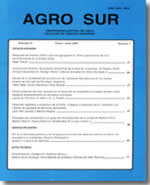Response of shallots (Allium cepa var. aggregatum G. Don ) to lime and boronatrocalcita in an acid soil
Main Article Content
Abstract
It is well known that the acid soils of southern Chile require lime applications in order to improve growth and development of cultivated plants, and consequently increase their yields; nevertheless, these applications have not overcome a foliar chlorosis that presents itself in shallots and garlics, which limits their yield.
Preliminary research conducted in garlic has indicated that the foliar chlorosis could be due to boron deficiency; therefore this study was conducted to examine the effect of applications of boronatrocalcita and lime on folia chlorosis in garlic.
Results indicated that the application of both lime and boronatrocalcita to the furrow of planting improved the total and commercial yield of bulbs, with no occurrence of foliar cholorosis in treatments containing boron. The yields also differed depending on the amount of boronatrocalcita applied (20 versus 40 kg/ha), but this was not so for lime (2 versus 4 t/ha applied). The treatment without lime and boronatrocalcita had the lowest yield, showing a severe foliar cholorosis.
If the harvested bulbs are separated in their corresponding bulbils these were more than 3 million/ha in treatments including both lime and boronatrocalcita; compared with 2.3 millon in the treatment without them. Nevertheless, it is possible that the higher rate of lime applied to the furrow (4 t/ha) might have affected the normal absorption of boron, as shown by the higher total commercial production of bulbils with only 2 t/ha of lime plus 40 kg/ha of boronatrocalcita. However, when only the larger commercial bulbils (over 10 grams) are considered, the rate of 4 t/ha of lime was superior, with no occurrances of foliar chlorosis.

